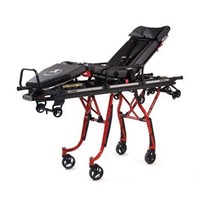A common question we get asked- should I purchase a stretcher or a hospital bed, which one is best for accommodating the type of patient and workflow we have?
Well, for everyone having this debate right now, there are some key points for you to consider:
- Cost
- Size
- Maneuverability
- Maintenance
- Lifespan
Stretcher vs. Hospital Beds
Stretchers or patient trolleys are designed to be compact for best maneuverability, offering close access to the patient for examination, emergency or surgical care, with simple functional controls for speed and ease of the operator. The mattresses are generally thinner, developed for short stay, to facilitate easy transfer and to assist in special procedures or radiology.
Ward beds or hospital beds are designed with longer and wider platforms and thicker mattresses for long stay patient comfort. The beds' dropside style allows for maximum patient support and regularly has integrated controls which gives the patients more independence.
Stretcher vs. Hospital Bed costs?
Stretchers can start anywhere from $5,000-$12,000 depending on the level of customisation.
Hospital beds can cost less ranging from $3,000 - $10,000, it is also very hard to give an exact amount on these products as like a stretcher, price can change dramatically depending on things like accessories, technology, manufacturer and freight costs to name a few.
Stretcher vs. Hospital Bed size?
Usually, a patient transport stretcher is approximately 2150mm long x 850mm wide overall (including the corner bumpers). This sizing allows the stretcher to move through common doorway sizes and fit into most personnel lifts across a medical facility.
As a general guide, the most common size for a hospital bed is 1000mm wide by 2200mm in length. The beds can come in multiple sizes depending on the make and model, some with the inbuilt capacity to increase size both in length and width.
Stretcher vs. Hospital Bed maneuverability?
Patient transport trolleys are a high strength, lighter weight construction, built to effectively move patients with the minimum amount of staff input. As patient trolleys are regularly on the move, the castor types, steering and braking systems are characteristically engineered stronger and larger than ward beds, to ensure a lifetime of heavy use. Trolleys and stretchers can be easier and faster to repair in the event of damage, as they are designed to absorb the expected impacts associated with movement.
Hospital ward beds however, are not built for regular patient transportation, they are traditionally wider, longer and heavier in construction with smaller wheels. The extra size and weight of beds can make it more challenging to maneuver through doorways, hallways and in lifts. An extra staff member may be required to assist in transport to help reduce risk of strain injury.
Stretcher vs. Hospital Bed maintenance?
As stretchers are used for high patient throughput in both day procedure and emergency care, they are designed to be simple to service and well protected for more efficient cleaning that is required by critical infection control standards.
Ward beds will mostly have less covers and more exposed framework that is harder or more time consuming to clean multiple times a day. Due to the rigorous use of patient stretchers, they tend to have less technical functionality for simplicity in the high number of staff users, to reduce breakdown risk and allow fast repairs. Ward beds can have a high level of electronic functionality that offers excellent levels of patient positioning, angles, weight, lights and alarms. However, excessive movement and wear and tear of hospital beds can result in beds left out of action for extended periods of time with expensive repairs.
Stretcher vs. Hospital Bed lifespan?
If your patient trolleys are following the recommended maintenance schedule from your manufacturer the expected life is 10 years and this is considered a fair lifespan for a stretcher- given the demanding and continuous use it’s expected to perform.
A hospital bed is also estimated to last between 10-15 years however, specific components of the bed frame may need to be replaced during this time.
Well, we hope this article has helped to clear a few things up about the differences between a stretcher and a hospital bed and that you are now armed with a little more knowledge to help make an informed decision.
If you have any questions, don’t hesitate to contact our Team who will be more than happy to help in any way they can.





-160x160-state_article-rel-cat.png)























